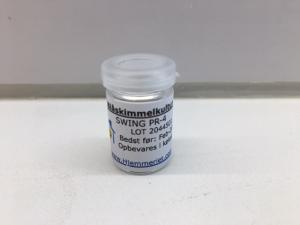Webshop
My page
 See Product Group See Product Group
|
Read more about Cheese |
Add to cart
|
|
|

|
LAF TRIO is a blend of defined yeast strains with origin in traditional French cheese making. They have been especially selected for their ability to prevents the growth of contaminant at the surface of the cheese. The synergetic effect from the strains inhibits contaminant, e.g. blue molds and mucor.
LAF TRIO may be used in lactic curd, soft cheeses with washed surface and Continental cheese with natural rind. The culture works in different ways:
- by generation a protective film on the cheese surface
- by allowing the consumption of residual sugars
- by accelerating the curd neutralisation.
LAF TRIO can also be used for Kefir production. It provides a light yeast flavor characteristic and acts as a bio-protection against contaminating moulds.
This product is developed for use in the production of dairy based milk cheeses.
Directions:
Add the culture to the milk before renneting and/or apply to the surface of the cheese a few hours after salting, by spraying or washing. For direct milk inoculation, no particular cautions are required.
For surface application:
1) Suspend the content of the pouch in 1 litre of sterile water.
2) Shake well before use.
A prepared suspension using one litre of water is sufficient for about 250 kg of cheese, and should be used on the day ofpreparation.
Note: When applying LAF TRIO to blue mould cheese, the culture it is recommended to be sprayed onto the cheese a few hours after salting. Picture below show effect of addition of LAF TRIO to cheese ripened with P. roquefortii.
LAF TRIO is active at temperatures ranging from 2 - 35°C, with an optimum growth temperature in the range 20 - 30°C.
Dosing small amounts of culture is made easy with our spatula micro spoon.
Applying mold culture onto the cheese can be done using a spray bottle.
|
Loading...
Content
Contents: 1 g.
DosageContents of 1 g is intended for 500 liter. Note om dosering af bakteriekulturer og enzymer
Storage and DurabilityStore in freezer (-18°C).
DocumentsFor additional information - please see the following links: For additional information - please see the following links:Culture OverviewUse the following to understand your possibilities for choosing cultures and enzymes for the production of butter, soured milk or cream, yogurt and cheese. Read the introductory explanations first. This explains the basics you need to understand the range of possibilities. Read this firstTo make dairy products you typically need starter cultures and eventually enzymes and ripening cultures.
Bacteria strains used in starter cultures are classified based on their temperature for optimal growth: A mesophilic starter culture contains mesophilic bacteria strains only. In addition to the mesophilic/thermophilic classification, bacteria strains are divided into classes (O, D, L, T, Y, A and B), depending on specific properties of the bacteria strains. The O, D and L classes are mesophilic. The T, Y, A and B classes are thermophilic. The starter culture tables show which bacteria strains each starter culture includes. Additional information is available for the starter cultures:
The starter cultures contain blends of bacteria strains depending on the style of the dairy product being made. Some of the cultures are shown to contain the same strains of bacteria; however, those cultures are not identical. They each have a different ratio, percentage or contains individual sub-spieces of strains in order to give the desired result. Bacteria strains from class D and L are heterofermentive and will produce lactic acid along with CO2 (gas) and diacetyl and/or other components which will contribute a buttery taste. All other acidifying classes are homofermentive, producing only lactid acid and will contribute a more simple acidic taste. For ripening cultures, proteolysis specifies in which degree the microorganisms breaks down the milk proteins, which contribute to the development of flavour and texture of the product. Lipolysis specifies in which degree the microorganisms breaks down the milk fats, thereby contributing to the development of fatty acid flavour and texture of the product. Suggestions on startersLoading... Culture overviewLoading... MicroorganismsLoading... FactsCurrent storage information:
|
|||||||||||||||||||||||||||||||||||||||||||||||||||||||||||||||||||||||||||||||||||||||
|
|


















































































































































































 In stock
In stock 
 2/10
- Visitors: 1502196 - 1
2/10
- Visitors: 1502196 - 1